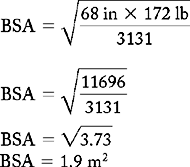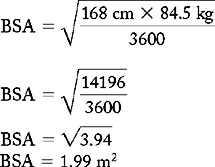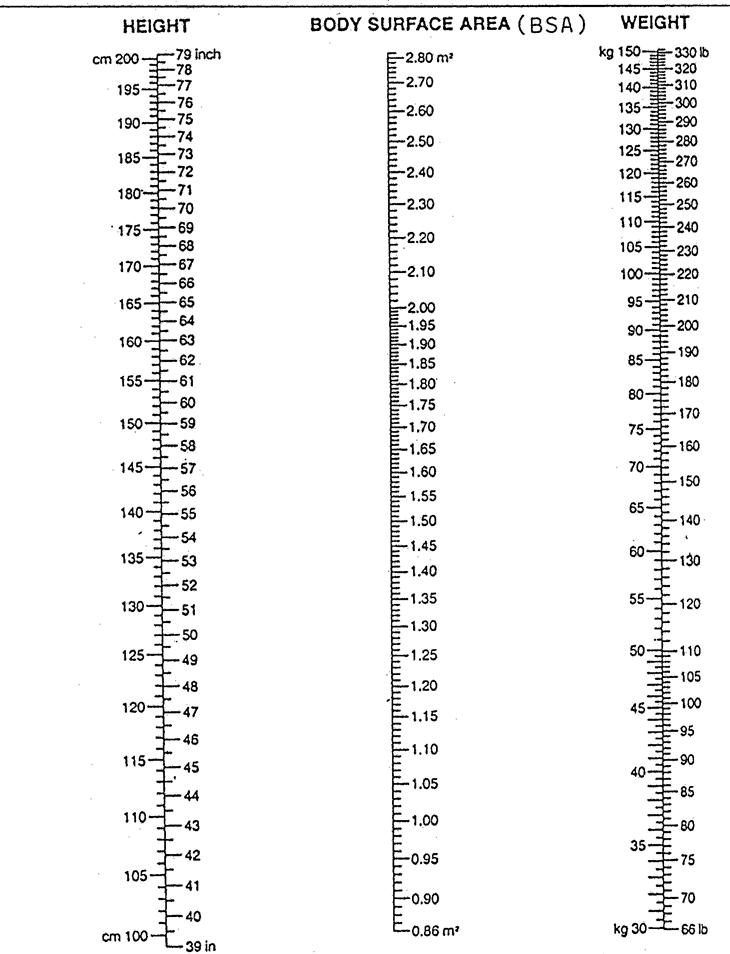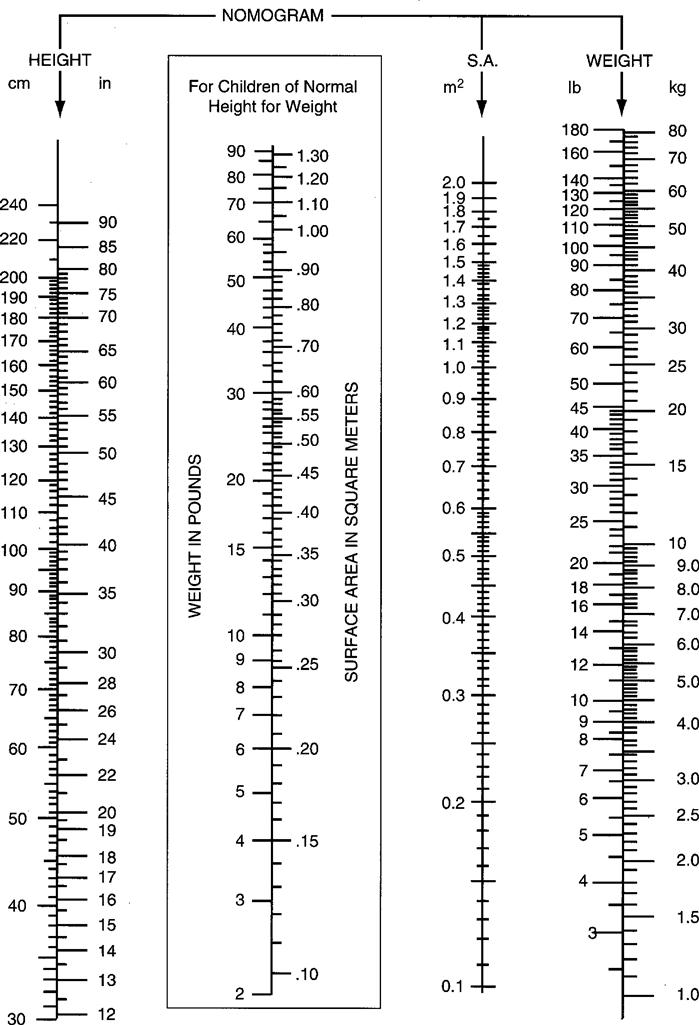METHODS OF CALCULATION FOR INDIVIDUALIZED DRUG DOSING
Objectives
• State the differences between the weight formulas used for drug calculations.
• Calculate drug dosages according to body surface area.
• Calculate drug dosages according to body weight.
• List indications for use of ideal body weight, adjusted body weight, and lean body weight formulas.
CALCULATION FOR INDIVIDUALIZED DRUG DOSING
The two methods for individualizing drug dosing are body weight (BW) and body surface area (BSA). Other formulas that are associated with drug dosing, especially in bariatrics, are ideal body weight (IBW) and lean body weight (LBW).
Body Weight (BW)
Drug dosing by actual BW is the primary way medication is individualized for adults and children. Manufacturers supply dosing information in the package insert. The insert data provide the dosage based on the patient’s weight in kilograms (kg). The first step is to convert pounds to kilograms (if necessary). The second step is to determine the drug dose per BW by multiplying drug dose × body weight (BW) × frequency (day or per day in divided doses). The third step is to choose one of the four methods of drug calculation for the amount of drug to be given.
EXAMPLES
PROBLEM 1: Order: fluorouracil (5-FU), 12 mg/kg/day IV, not to exceed 800 mg/day. The adult weighs 140 pounds.
a. Convert pounds to kilograms. Divide number of pounds by 2.2.
Remember: 1 kg = 2.2 lb
140 lb ÷ 2.2 lb/kg = 64 kg
b. Dosage/BW: mg × kg × 1 day =
12 × 64 × 1 = 768 mg IV per day
ANSWER: fluorouracil (5-FU), 12 mg/kg/day = 768 mg or 770 mg
PROBLEM 2: Give cefaclor (Ceclor), 20 mg/kg/day in three divided doses. The child weighs 20 pounds.
Drug available:
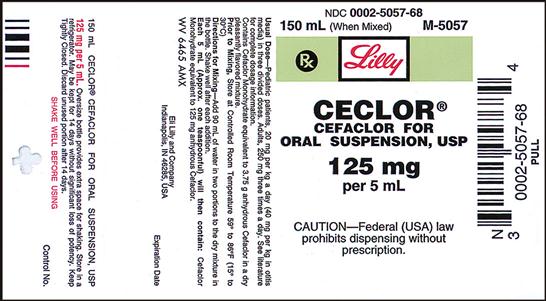
a. Convert pounds to kilograms
20 lbs ÷ 2.2 lb/kg = 9 kg
b. Dosage/BW: 20 mg × 9 kg × 1 day = 180 mg per day.
180 mg ÷ 3 divided doses = 60 mg






ANSWER: cefaclor (Ceclor) 20 mg/kg/day = 2.4 mL per dose three times per day
Body Surface Area (BSA or m2)
Body surface area is an estimated mathematical function of height and weight. BSA is considered to be the most accurate way to calculate drug dosages in that the correct dosage is more proportional to the surface area. BSA is commonly used in chemotherapy and some drug dosages used for infants and children.
BSA with the Square Root
BSA can be calculated by using the square root and a fractional formula of height and weight divided by a constant, one for the metric system and another for inches and pounds. Now that calculators are readily available, research has shown that this method results in fewer errors than drawing intersecting lines on a nomogram. Conversion of weight and height to the same system of measure is necessary first.
BSA: Inch and Pound (lb) Formula

BSA: Metric Formula by Centimeters (cm) and Kilograms (kg)

EXAMPLES
PROBLEM 1: Order: melphalon (Alkeran) 16 mg/m2 q 2 weeks. Patient is 68 inches tall and weighs 172 pounds. Use the BSA inches and pounds formula.
PROBLEM 2: Order: cisplatin (Platinol) 50 mg/m2/cycle IV. Patient weighs 84.5 kg and is 168 cm tall. Use the BSA metric formula.
BSA with a Nomogram
The BSA in square meters (m2) is determined by the person’s height and weight and where these points intersect on the nomogram scale (Figures 7-1 and 7-2). The nomogram charts were developed from the square root formulas and were correlated with heights and weights to simplify drug dosing before calculators were readily available. When a nomogram is used, points on the scale must be carefully plotted. An error in plotting points or drawing intersecting lines can lead to reading of the incorrect BSA, resulting in dosing errors. There are discrepancies between the nomogram and the square root method. The trend in medication safety is to use the square root.
To calculate the dosage by BSA obtained with nomogram, multiply the drug dose × m2, e.g., 100 mg × 1.6 m2 = 160 mg/m2. The advantage of using the nomogram is that no conversions from pounds to kilograms or inches to centimeters are needed.
EXAMPLES
PROBLEM 1: Order: cyclophosphamide (Cytoxan) 100 mg/m2/day, po. Patient weighs 150 pounds and is 5′8″ (68 inches) tall.
a. 68 inches and 150 pounds intersect the nomogram scale at 1.88 m2 (BSA).
b. BSA: 100 mg × 1.9 m2 = 190 mg/m2/day of Cytoxan.
1.88 m2 = 188 mg/m2/day or 190 mg/m2/day
PROBLEM 2: Order: cytarabine (cytosine arabinoside) 200 mg/m2/day IV × 5 days for a patient with myelocytic leukemia. The patient is 64 inches tall and weighs 130 pounds.
Ideal Body Weight (IBW)
Drug dosing by ideal body weight (IBW) or lean body weight/mass (LBW)/(LBM) formulas is used for medications that are poorly absorbed and distributed throughout the body fat. The ideal body weight formula is based on height and can be adjusted for weight and is used for nutritional assessment. The lean body weight/mass formula is based upon height and weight but is less frequently used because it may predict insufficient doses in obese patients.
IBW Formula
Male: 50 kg + 2.3 kg for EACH inch over 5 feet
Female: 45.5 kg + 2.3 kg for EACH inch over 5 feet
EXAMPLE
Female is 5 feet 2 inches (2 inches × 2.3 kg)
IBW: 45.5 kg + 2 (2.3 kg) = 45.5 kg + 4.6 kg = 50.1 kg
Adjusted Body Weight (ABW)
Adjusted body weight (ABW) is used for dosing some medication for obese individuals or pregnant women. ABW is better for nutritional assessment of obese individuals because it prevents overfeeding. The ABW formula uses both the IBW and the actual body weight with adjustments for male and female.
ABW Formula
Male: IBW + 0.4 (Actual Body Weight [kg] − IBW [kg]) = ABW
Female: IBW + 0.4 (Actual Body Weight [kg] − IBW [kg]) = ABW
EXAMPLE
Female is 5 feet 2 inches and weighs 100.5 kg
50.1 kg + 0.4 (100.5 − 50.1 kg) =
50.1 kg + 0.4 (50.4 kg) =
50.1 kg + 20.16 kg = 70.26 kg or 70.3 kg
Lean Body Weight (LBW)
Lean body weight (LBW) is the weight of bone, muscle, and organs without any fat. LBW is used for the dosing of some medications and can be used as an indicator of overall health for patients with chronic diseases.
LBW Formula
Lean body weight in kilograms (males over 16 years of age) = (0.32810 × [body weight in kg] + 0.33929 × [height in centimeters]) − 29.5336
Lean body weight in kilograms (women over 30) = (0.29569 × [body weight in kg] + 0.41813 × [height in centimeters]) − 43.2933
EXAMPLE
Female is 5 feet 2 inches, weighs 100.5 kg, and is 55 years old.
(0.29569 × [100.5 kg] + ([0.41813 × (62″ × 2.54 cm)]) − 43.2933 = 29.71 + (0.41813 × 157.48) − 43.2933 = 29.71 + 65.84 − 43.2933 = 95.55 − 43.2933 = 52.26 kg

